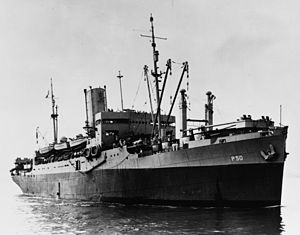USS Joseph Hewes (AP-50)

Photographed in 1942
|
|
| History | |
|---|---|
|
|
|
| Namesake: | Joseph Hewes |
| Ordered: | as SS Excalibur |
| Builder: | New York Shipbuilding Co. |
| Yard number: | Camden, N.J. |
| Laid down: | 4 November 1929 |
| Launched: | 5 August 1930 |
| Completed: | 18 December 1930 |
| Acquired: | 8 January 1942 |
| Commissioned: |
|
| Struck: | struck from the Naval Register, 7 December 1942 |
| Fate: |
|
| Notes: |
|
| General characteristics | |
| Displacement: | 14,100 t. |
| Length: | 450 ft (140 m) |
| Beam: | 61 ft 6 in (18.75 m) |
| Draught: | 26 ft 4 in (8.03 m) |
| Propulsion: | steam turbines |
| Speed: | 15 kts. |
| Complement: | 358 |
| Armament: | one single 5"/38 dual purpose gun mount, four single 3"/50 gun mounts, 8 single 20mm gun mounts |
USS Joseph Hewes (AP-50), formerly SS Excalibur, was a troop transport for the United States Navy during World War II commanded by Captain Robert McLanhan Smith Jr. A part of the Center Attack Group of Admiral Hewitt's Western Naval Task Force, Operation Torch, Joseph Hewes was sunk on November 11, 1942 by the German submarine U-173 in Fedala Roads off French Morocco coast during the Naval Battle of Casablanca.
She was built by the New York Shipbuilding Corporation, and launched in 1930 in Camden, New Jersey as the combination passenger-cargo luxury liner SS Excalibur. One of American Export Lines "4 Aces" sister ships — SS Excalibur, SS Exeter, SS Excambion and SS Exochorda — she provided regular service between New York and Europe. SS Excalibur departed on her maiden voyage on January 24, 1931, sailing from New York City to Marseilles, Naples, Alexandria, Jaffa, Haifa, Beirut, and then turning back and stopping at Alexandria, Naples, Leghorn, Genoa, Marseilles and finally reaching New York. In August 1940, Excalibur carried the Duke and Duchess of Windsor from Lisbon to Bermuda, where she stopped on a special call.
...
Wikipedia
